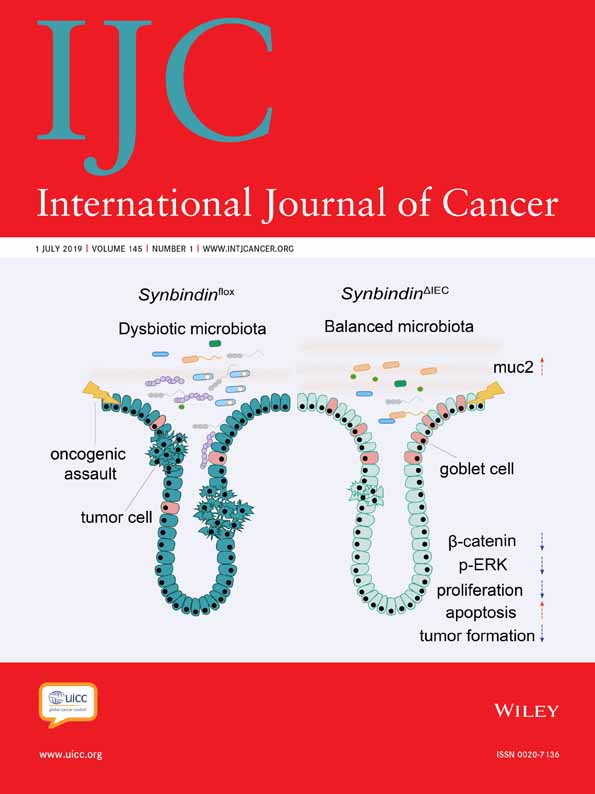| ijc32100-sup-0001-supinfo.docxWord 2007 document
, 2 MB |
Table S1 Clinical, demographic and tumor pathological characteristics of 1,401 patients diagnosed with colon cancer from 1995 to 2011 (inclusive). CEA, carcinoembryonic antigen; ASA, American Society of Anesthesiologists score; ECOG, Eastern Cooperative Oncology Group Performance Status.
Table S2. Web addresses for colon cancer survival calculators. OS, overall survival; RFS, recurrence-free survival.
Table S3. Clinical, demographic and tumor pathological characteristics of 611Stage I-III colon cancer patients from the MCO dataset with known perineural invasion status diagnosed with colon cancer. These data were used for the imputation perineural invasion status in the ACCORD dataset.
Table S4. Clinical, demographic and tumor pathological characteristics of 587 Stage II/III colon cancer patients from the MCO dataset with known perineural invasion status diagnosed with colon cancer. These data were used to assess the calibration for applicable colon cancer prognosis calculators (Supplementary Table 5).
Table S5. Comparison of colon cancer nomograms for prediction of outcome for 587 patients from the MCO database with stage II/III colon cancer. Note that 576 of 587 patients had usable CSS data. The difference (Diff.) is calculated as predicted (Pred.) minus observed (Obs.). Predictions were not available for all patients due to missing data on some features required for various predictions. The percentage of predictions that could be made is tabulated. * P < 0.05.
Table S6. Calibration of survival calculators in patients with stage III colon cancer with ≥12 examined lymph nodes and receiving adjuvant treatment. The calibration difference (Diff.) is calculated as predicted (Pred.) minus observed (Obs.) survival percentages; 95% confidence intervals (95% CI) are shown. Calibration is for 3-year survival for the Mayo Clinic recurrence-free survival calculator, and for 5-year survival for all other calculators. OS, overall survival; RFS, recurrence-free survival; CSS, cancer-specific survival; A!O (1), Adjuvant! Online model 1; A!O (2), Adjuvant! Online model 2;MSKCC, Memorial Sloan Kettering Cancer Center; MDA, MD Anderson Cancer Center; MC, Mayo Clinic; *P < 0.05; **Percentage of patients for whom predictions could be made.
Table S7. Calibration of survival calculators in an Australian community cohort of patients with stage II/III colon cancer for subgroups by age, ASA score, ECOG status, gender and tumor location. The calibration difference (Diff.) is calculated as predicted (Pred.) minus observed (Obs.) survival percentages. Calibration is for 3-year survival for the Mayo Clinic recurrence-free survival calculator, and for 5-year survival for all other calculators. OS, overall survival; RFS, recurrence-free survival; CSS, cancer-specific survival; A!O (1), Adjuvant! Online model 1; A!O (2), Adjuvant! Online model 2;MSKCC, Memorial Sloan Kettering Cancer Center; MDA, MD Anderson Cancer Center; MC, Mayo Clinic; *P < 0.05; **Percentage of patients for whom predictions could be made.
Table S8. Discrimination of survival calculators in an Australian community cohort of patients with stage II/III colon cancer, compared to the AJCC 7th edition tumor staging system (AJCC7). Point estimates and 95% confidence intervals (95% CI) are shown for C-indices (C). OS, overall survival; RFS, recurrence-free survival; CSS, cancer-specific survival; A!O (1), Adjuvant! Online model 1; A!O (2), Adjuvant! Online model 2; MSKCC, Memorial Sloan Kettering Cancer Center; MDA, MD Anderson Cancer Center; MC, Mayo Clinic; *P < 0.05.
Table S9. Discrimination of survival calculators in patients with stage III colon cancer with ≥12 examined lymph nodes and receiving adjuvant treatment, compared to the AJCC 7th edition tumor staging system (AJCC7). Point estimates and 95% confidence intervals (95% CI) are shown for C-indices (C). OS, overall survival; RFS, recurrence-free survival; CSS, cancer-specific survival; A!O (1), Adjuvant! Online model 1; A!O (2), Adjuvant! Online model 2;MSKCC, Memorial Sloan Kettering Cancer Center; MDA, MD Anderson Cancer Center; MC, Mayo Clinic.
Figure S1.Mean observed versus predicted 5-year survival by quintiles of predicted outcome for (A) stage II colon cancer patients and (B) stage III colon cancer patients. Vertical bars are 95% confidence intervals of observed survival. The gray dashed line is the line of equality for observed versus predicted survival percentages. The solid, purple line indicates a least squares fit of observed versus predicted survival percentages. The P values (Pslope) shown in the bottom right of each panel are for the differences between the slopes of the fitted lines and a line with slope = 1. The P values (PN-DA) shown in the upper left of each panel are from the Nam-D'Agostino test which compares the observed quintiles of survival against the corresponding predictions.
Figure S2. Mean observed versus predicted survival by quintiles of predicted outcome for patients with stage III colon cancer with ≥12 examined lymph nodes and receiving adjuvant treatment. Vertical bars are 95% confidence intervals of observed survival. Data are for 3-year survival for the Mayo Clinic's recurrence-free survival calculator, and for 5-year survival for all other calculators. The gray dashed line is the line of equality for observed versus predicted survival percentage. The solid, purple line indicates a least squares fit of observed versus predicted survival percentages. The P values (Pslope) shown in the bottom right of each panel are for the differences between the slopes of the fitted lines and a line with slope = 1. The P values (PN-DA) shown in the upper left of each panel are from the Nam-D'Agostino test which compares the observed quintiles of survival against the corresponding predictions.
|




